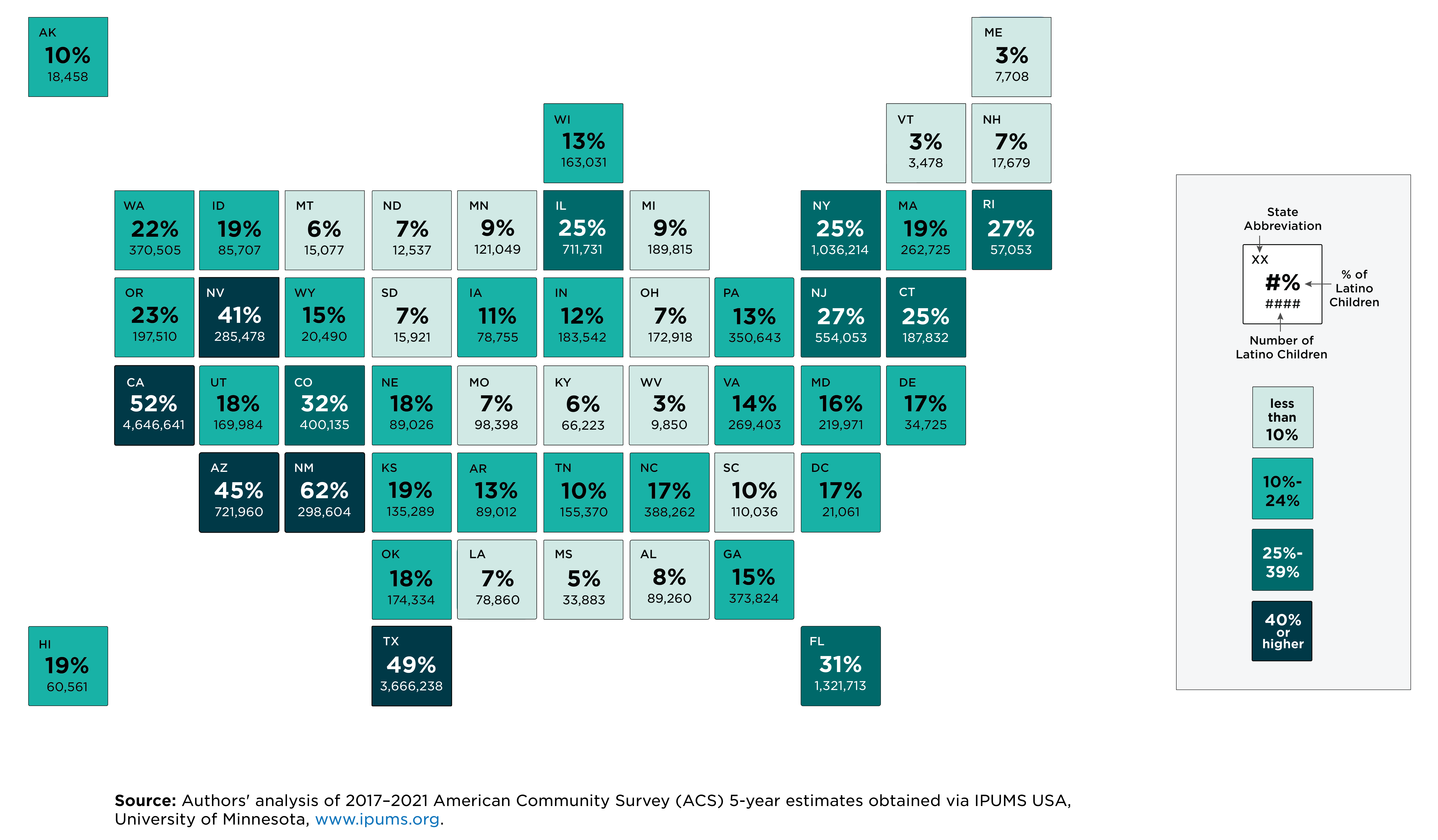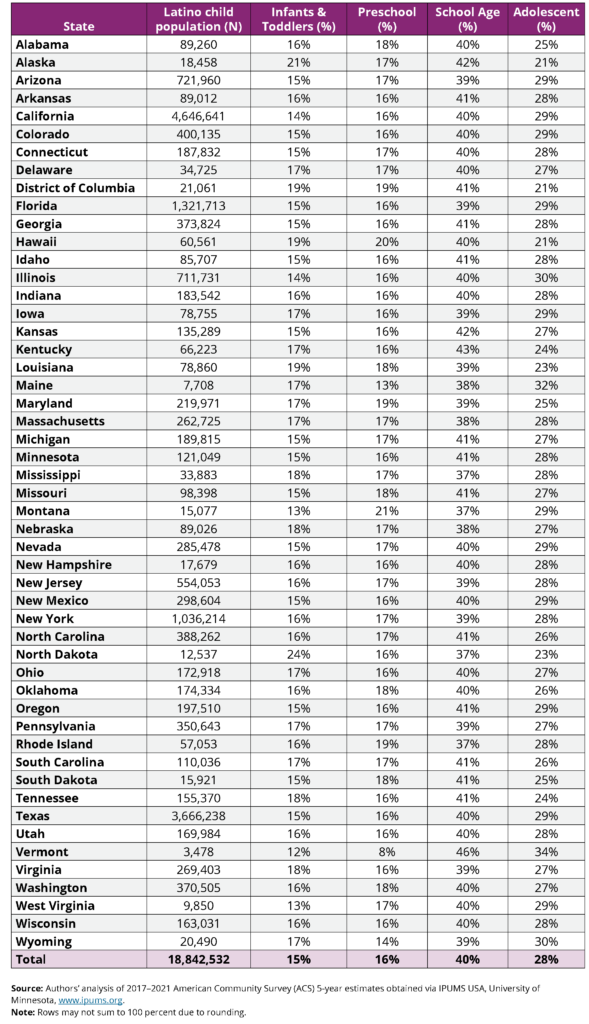Sep 27, 2023
Data Point, Research Publication
One in Four Children Nationwide Are Latino, With 6-to-12-year-olds Making Up Nearly 40 Percent of Latino Children
Authors:
The nearly 19 million Latino childrena (from birth to age 17) living in the United States comprise 25 percent of the nation’s total child population.b The size of the Latino child population, however, varies by state. In this data point, we describe the share and distribution of the Latino child population in all 50 states and the District of Columbia. In addition, we analyze the age distribution of the Latino child population, detailing the proportion of Latino children that are infants and toddlers, preschoolers, school-age, and adolescents in each state. These estimates can inform potential demand for a wide range of policies and programs for children from birth onwards, such as family leave, early childhood care and education, child health insurance, and public school policies.
Latino share of the child population by state
Our new analysis of the American Community Survey (ACS) 2017–2021 5-Year Data finds that Latino children are most populous in the Southwestern states and comprise a sizeable proportion (10% or more) of the child population in 35 states and the District of Columbia.c
- Latino children make up more than 40 percent of the child population in five states: New Mexico (62%) and California (52%) are highest, but Latino children also comprise over 40 percent of all children in Texas, Arizona, and Nevada.
- Latino children account for 25 to 39 percent of the child population in seven more states: Colorado, Florida, New Jersey, Rhode Island, Connecticut, Illinois, and New York.
- Latino children account for 10 to nearly 25 percent of the child population in the District of Columbia and in 23 states: Oregon, Washington, Hawaii, Kansas, Massachusetts, Idaho, Nebraska, Oklahoma, Utah, North Carolina, District of Columbia, Delaware, Maryland, Wyoming, Georgia, Virginia, Pennsylvania, Wisconsin, Arkansas, Indiana, Iowa, Tennessee, Alaska, and South Carolina.
- Latino children account for less than 10 percent of the child population in 15 states: Minnesota, Michigan, Alabama, South Dakota, Louisiana, Missouri, North Dakota, New Hampshire, Ohio, Kentucky, Montana, Mississippi, Maine, Vermont, and West Virginia.
Latino Children are 10 percent or more of the child population in 35 states and the District of Columbia
Size of the Latino child population by state
California, Texas, Florida, and New York each have more than 1 million young Latino residents: 4.6 million in California, 3.7 million in Texas, 1.3 million in Florida, and over 1 million in New York. Arizona, Illinois, and New Jersey (in order of population) have the next-largest Latino child populations, ranging from roughly 550,000 to 720,000. Around 200,000 to 400,000 Latino children live in Colorado, North Carolina, Georgia, Washington, Pennsylvania, New Mexico, Nevada, Virginia, Massachusetts, Maryland, and Oregon (also ordered by population). As we observed in 2019, Latino children continue to have a substantial and growing presence in several Midwestern states: Roughly 190,000 Latino children live in Michigan, with just over 180,000 in Indiana, just over 170,000 in Ohio, and just over 160,000 in Wisconsin.
Share of Latino children that are infants/toddlers, preschoolers, school-age, and adolescents
Looking at the age distribution of Latino children, we find that, nationwide, Latino infants and toddlers (birth to age 2) account for 15 percent of all Latino children, preschool-aged children (ages 3–5) account for 16 percent, school-aged children (ages 6–12) account for nearly 40 percent, and adolescents (ages 13–17) account for 28 percent.
Across states, the age distribution of the Latino child population varies to some extent, with some states having younger Latino child populations, on average, while others have older child populations. For example, at the state level, Latino infants and toddlers account for 19 percent or more of Latino children in North Dakota, Alaska, Louisiana, Hawaii, and District of Columbia. These states also have the lowest percentages of Latino children that are adolescents, ranging from 21 to 23 percent. Tennessee, Mississippi, Nebraska, and Virginia have the next-highest percentage (18%) of Latino children that are infants and toddlers. Looking at Latino preschool-aged children (ages 3–5), we find that they comprise 21 percent of Latino children in Montana, 20 percent in Hawaii, and 19 percent in the District of Columbia, Rhode Island, and Maryland. In terms of Latino school-aged children, Vermont and Kentucky have the largest share of their Latino child population being school-aged—46 percent and 43 percent, respectively. Vermont, Maine, Illinois, and Wyoming have the largest share of Latino children who are adolescents, from 30 to 34 percent. Similarly, Vermont and Illinois have the smallest share of Latino children who are infants and toddlers (12% and 14%, respectively), along with Montana, West Virginia, and California (all less than 15%).
Age distribution of the Latino child population, by state and in the District of Columbia, 2017-2021

Size of the Latino child population in each age range
The six states with the largest number of Latino infants/toddlers and preschoolers, school-aged, and adolescent children also have the largest number of Latino children overall. California and Texas each have more than 559,000 Latino infants and toddlers, more than 596,000 preschool-aged Latino children, more than 1.4 million who are school-aged, and more than 1 million who are adolescents. Florida, New York, Arizona, and Illinois (in order of population) have the next-highest Latino infant and toddler population, ranging from 100,000 to 200,000. The same four states are also home to the next-highest Latino child populations for the preschool, school-aged, and adolescent age groups, although their order of population varies slightly. Each of these six states also have the largest Latino child populations across all 50 states.
Footnotes
a We define Latino children as children under age 18 for whom a Latino or Hispanic origin (of any race) was reported. We use “Hispanic” and “Latino” interchangeably. Consistent with the U.S. Census definition, this includes individuals who have origins in Mexico, Puerto Rico, and Cuba, as well as other “Hispanic, Latino or Spanish” origins.
b These estimates are based on the Center’s new analysis of data from the 2017–2021 American Community Survey (ACS) 5-Year survey. We used the ACS 5-year data as opposed to ACS 1-year data in order to have a sufficient sample size for each age range of Latino children we examined across the 50 states and the District of Columbia.
c All lists of states in this section are ordered by percentage of the state’s child population that is Hispanic.
Suggested Citation
McClay, A., Guzman, L., & Chen, Y. (2023). One in four children nationwide are Latino, with 6- to 12-year-olds making up nearly 40 percent of Latino children. National Research Center on Hispanic Children & Families. https://doi.org/10.59377/742k5256h




